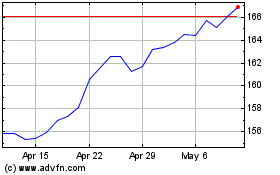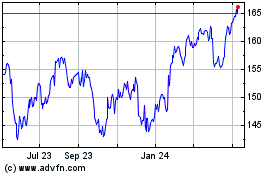By David Benoit and Sharon Terlep
One of the biggest activist investors has built up a more than
$3 billion stake in Procter & Gamble Co., adding urgency to the
consumer-product giant's efforts to turn around its business and
boost its stock price.
Trian Fund Management LP, which in previous years has targeted
companies like PepsiCo Inc. and DuPont Co., disclosed Tuesday it
had bought shares in P&G, which has a market value of $225
billion. Trian's bet, at more than $3 billion, according to a
person familiar with the matter, is its largest investment ever.
It's unclear what changes Trian, which is known for publishing
detailed research reports on its investment targets, will seek at
the maker of Tide detergent, Gillette razors and Pampers
diapers.
"P&G welcomes investment in our company," the Cincinnati
company said, after The Wall Street Journal first reported on
Trian's investment Tuesday. Shares of the company, which have
lagged behind the broader market for the past year, jumped 3% in
late trading to $90.40.
P&G has been slashing costs and shedding dozens of brands to
refocus on its biggest businesses. But it has struggled to boost
sales growth as it battles a sluggish global economy, price
pressures and competition from internet upstarts like the Dollar
Shave Club.
Historically, Trian has focused on companies it believes need
tighter focus on core operations, as well as on cutting costs and
management bureaucracy. As with other activists, it also is known
for advocating for asset sales or breakups. Trian sometimes works
quietly from inside the boardroom and at other times wages public
battles for influence.
Trian didn't speak with P&G executives about its investment
before disclosing it publicly, people familiar with the matter
said.
This isn't the first time P&G has faced an activist. In
2012, William Ackman's Pershing Square Capital Management LP
invested in the company and called for a CEO change amid slumping
profits. A year later, Robert McDonald was replaced by his old
boss, A.G. Lafley, who remained chairman until last year. Company
veteran David Taylor is now chairman and CEO.
Mr. Taylor, who took over in November 2015, has opted against
launching new brands or buying a hot startup, instead relying on
P&G's traditional fundamentals: selling to the masses by way of
big retailers on the strength of meticulously collected consumer
research; a massive research-and-development operation; and the
world's biggest advertising budget.
"I understand the desire for faster growth and for a
single-minded short-term objective, but we've seen this movie
before, and frankly, we don't want to live the sequel," Mr. Taylor
said at a meeting with analysts in November after his first year at
the helm.
The company's closely watched organic sales growth, which
excludes acquisitions or divestments as well as currency swings,
has been stuck between 1% and 3% in recent years. In January,
P&G increased its target for the year ending in June to between
2% and 3% -- though that is still well below prerecession
levels.
Bernstein analyst Ali Dibadj has long advocated a breakup of
P&G. He said P&G's resistance to change may prompt Trian to
take a more active role. "We have always tried to keep P&G's
feet to the fire as we don't think it's living up to its
potential," he said. "We can imagine Trian sees the same thing and
will do the same."
P&G shares have gained 5.7% this year including dividends,
outpacing the S&P 500's 4.2% return, but the share's price has
trailed the benchmark over the past one-year and three-year
periods.
P&G fared better than many of its rivals in the second half
of 2016, capturing market share in many categories. Analysts say
the environment is tough for consumer-staples sellers, also because
of macroeconomic factors like currency volatility. Several big
research firms have downgraded P&G shares, including Goldman
Sachs Group Inc., which put a sell rating on the company in
January.
P&G, General Electric Co. and some other American
corporations are rushing to shed underperforming divisions and slim
down after years of bulking up through acquisitions outside their
core expertise. The change of heart among top executives was seen
as an admission that their companies had grown too big and bloated
to manage effectively, which caused their stock prices to languish
in recent years. It also came as activist investors used their war
chests to pressure boards to move more quickly.
P&G spent $80 billion over two decades scooping up brands
including Gillette razors, Duracell batteries and Iams pet food,
only to end up selling some of them to focus on boosting sales of
Tide, Pampers and other mainstays. In October, P&G completed
the $11.6 billion sale of dozens of beauty brands, including
CoverGirl makeup and Clairol hair dye, to Coty Inc., which included
the transfer of about 10,000 P&G employees.
The activist world has been in guessing mode on the new Trian
position, particularly since co-founder Nelson Peltz said in
December that he and his partners had started buying a new stock.
At that time, Mr. Peltz told CNBC that he hoped to talk to the
board and management before the investment became public, as the
firm has tried to distance itself from bare-knuckled activism and
position itself as a constructive, if opinionated, shareholder.
Trian didn't reveal a new investment in all of 2016, focusing
instead on its portfolio companies, after making three new
investments in 2015. One of them was then its biggest ever, a $2.2
billion stake in General Electric Co.
But it was also ramping up for this new bet by fundraising and
selling some other stakes. During 2016, it sold a $1.8 billion
investment in PepsiCo, after a three-year campaign that included a
bid to break up the soda and snack maker, and a $383 million
position in money-manager Legg Mason Inc., which marked one of the
few times in which Trian has helped remove a chief executive.
Trian raised a specific fund for the P&G position in recent
months, tapping large investment pools like sovereign-wealth funds
and pension funds, people familiar with the matter have said.
Trian on Tuesday disclosed a P&G stake of $539 million when
it released its portfolio as of the end of December. The investment
fund has continued buying throughout the new year and the stake has
risen to more than $3 billion, the people said.
Write to David Benoit at david.benoit@wsj.com and Sharon Terlep
at sharon.terlep@wsj.com
(END) Dow Jones Newswires
February 14, 2017 20:36 ET (01:36 GMT)
Copyright (c) 2017 Dow Jones & Company, Inc.
Procter and Gamble (NYSE:PG)
Historical Stock Chart
From Mar 2024 to Apr 2024

Procter and Gamble (NYSE:PG)
Historical Stock Chart
From Apr 2023 to Apr 2024
